
News
Behind the Headlines
Two-Cents Worth
Video of the Week
News Blurbs
Articles
Testimony
Bible Questions
Internet Articles (2017)
Internet Articles (2016)
Internet Articles (2015)
Internet Articles (2014)
Internet
Articles (2013)
Internet Articles (2012)
Internet Articles (2011)
Internet Articles (2010)
Internet Articles
(2009)
Internet Articles (2008)
Internet Articles (2007)
Internet Articles (2006)
Internet Articles (2005)
Internet Articles (2004)
Internet Articles (2003)
Internet Articles (2002)
Internet Articles (2001)
News
Behind the Headlines
Two-Cents Worth
Video of the Week
News Blurbs
Articles
Testimony
Bible Questions
Internet Articles (2017)
Internet Articles (2016)
Internet Articles (2015)
Internet Articles (2014)
Internet
Articles (2013)
Internet Articles (2012)
Internet Articles (2011)
Internet Articles (2010)
Internet Articles
(2009)
Internet Articles (2008)
Internet Articles (2007)
Internet Articles (2006)
Internet Articles (2005)
Internet Articles (2004)
Internet Articles (2003)
Internet Articles (2002)
Internet Articles (2001)

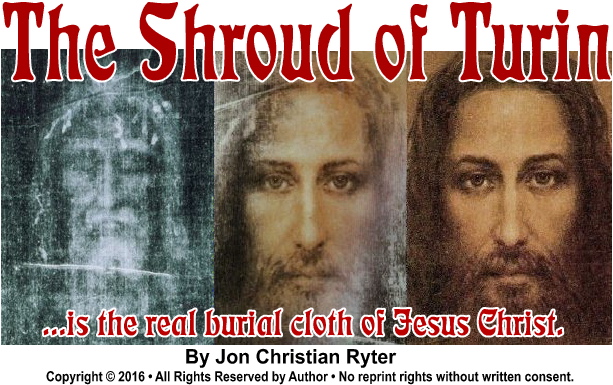
Before we we begin talking about the Shroud (a sindon) of Turin we need to take our first look at the scientists who determined it to be a fake. The trio consisted of the most prominent, Professor Edward T. Hall, as well as Dr. Michael Tite (the official invigilator of the carbon-dating project), and Dr. Robert Hedges. What made Hall the preeminent authority had nothing to with a superior knowledge of radiocarbon dating, but the fact that he was a millionaire and extremely influential in England. In addition Hall was an atheist who found radiocarbon dating a worthy scientific devise against what he called "the flat Earth fools." 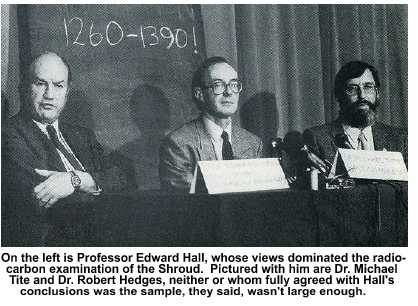 Hall was not shy about offering his opinion of Christians. Sometime after the supposedly scientific debunking of the Shroud, Hall told a group of reporters at a British Museum press conference that "...there was a multi-million-pound business in making forgeries during the 14th century."
Hall was not shy about offering his opinion of Christians. Sometime after the supposedly scientific debunking of the Shroud, Hall told a group of reporters at a British Museum press conference that "...there was a multi-million-pound business in making forgeries during the 14th century."
Contrary to Hall's opinion (stated, I believe, to further discredit the Shroud as being the one and only burial cloth of Jesus Christ) that there was an assembly line manufacturing of fake shrouds. There is, and always has been, only one Shroud. As it moved from one hiding place or another throughout history after being shown (usually without permission of the Catholic Church), the shroud gained the name of the village or town where it was briefly displayed. For example, at the end of the Fourth Crusade (sanctioned by Pope Innocent III), a French Knight Templar named Geoffroy de Charney of Lirey returned home with the burial cloth which either he or some other knight appropriated during the sacking of Constantinople (the first time in history that Constantinople had ever been conquered in battle) it was called the Shroud of Lirey. The Templar Knights (named after the Temple in Jerusalem in 1122), fell from grace in 1291 with the fall of the City of Acre to the Muslims. Holding Acre was critical to the Crusaders in order to launch an attack to regain Jerusalem, which they lost to Saladin in 1187. In 1291, Saladin routed the Crusaders at Acre, ending the 4th Crusade.
In 1306 King Phillip IV asked Pope Clement V to dissolve the Knights Templar, which the pope did in 1307 based on accusations made by a young Templar, Arnaut Sabbatier (who entered the order in 1287). Sabbatier testified at the trials of deCharney and the Templar leader Jacques deMoley that, in his initiation ritual into the Knights Templar, he was taken blindfolded to a secret meeting place where there was a long, linen cloth bearing the faint image of a bearded man . In his initiation, he was forced to venerate the image by kissing it's feet three times.
DeCharney and de Molay, were burned at the stake by order of Pope Clement V for worshipping idols in the form of the image of a bearded man on a piece of linen. Had the Church found the secret Templar hiding place, Pope Clement V would have had the Shroud burned with the Templar Knights.
With the martyrdom of Goeffroy I, the ownership of the Shroud of Lirey passed to his son, Goeffroy II. That part of the history of the Shroud was written by two Roman Catholic scholars, both of whom viewed the Shroud as a forgery because the Catholic Church in the 14th century viewed it as a forgery—although neither men ever saw the Shroud. The medieval Catholic Church said it was a fraud, therefore it was a fraud. (Note: I have the names of both historians but chose not to give credit to "historians" who allow personal bias to stand in the way of honest investigation, so their names do not merit mention.)
They did report that the Bishop of Troyes, Pierre d'Areis, was distressed when Pope Clement VII gave the deCharney family authority to exhibit—for veneration—a cloth bearing the likeness of Jesus Christ in Lirey, in 1389. Because of deCharney's position which was equivalent to what today would be a governor, bypassing the Bishop was simply a matter of writing the Pope's legate, Cardinal de Thury to inform the Cardinal he—d'Areis—had already declared the Shroud to be a fake. Pope Clement VII authorized the display of a "holy relic" but specifically not as an image of Jesus since, in 1389, such manufactured imagery based on the 3D characteristics of the image and the fact that the linen shroud is a negative photographic image, would be impossible even for the greatest artist in medieval times. We can take it to the bank that the Shroud of Turin (or Lirey) is not a forgery. Therefore, we need to accept, as fact, that the Shroud is supernaturally genuine.
What that means is the error belongs to radio-carbon dating "experts" Edward Hall, Michael Tite and Robert Hedges. Myself, I would lay the blame on the rich guy—the atheist. But, it wasn't completely their fault. The blame has to be shared with the Catholic Church which knew what it has but didn't need science to confirm it—not enough, at least, to give them a swatch of the actual twill linen, which to the Catholic Church, would have been a sacrilege. For that reason, the sample the Church allowed them to have came from a patched corner of the Shroud. When you know what you have venerated for 796 years is the actual burial shroud of Jesus Christ, you don't need anyone to verify it for you. Nor do you need them destroying the Shroud by chopping it up into little pieces to verify what you already know to be true.
In his British Museum of London press conference, Hall also told the gathered media: "Someone just took a piece of linen, faked it up and flogged it," without stopping to realize that couldn't have happened from the 12th century to the 19th century since the image on the Shroud (actually a sindon) is a photographic negative image of a man, described in the Word of God in the first century as a man who had been brutally flogged, had a crown of thorns hammered into his head, had much of his beard literally ripped from his face, bore nail marks in his wrists and ankles and had his chest slit open by Roman soldiers to prove that the man on the cross had died, negating the need for his legs to be broken with a large, wood mallet—fulfilling John 19:36 that "...not one bone in His body was broken."
But to a rich atheist, arrogance always trumps what he can't explain. Hall concluded, "Some people may continue to fight for the authenticity of the shroud—like the Flat Earth Society—but this settles it all as far as we are concerned." Hall, who viewed himself as a scientist forgot the cardinal rule for scientists. It is the word WHY? Until you can answer all of the unanswered WHYS, you have failed to reach the truth. Hall never found the truth because Hall didn't want to find the truth. He wanted the fame he would receive for debunking the Shroud.
The historic announcement debunking the Shroud of Turin as the burial cloth of Jesus Christ was made in a tiny room in the basement of London's British Museum on Oct. 13, 1986. The trio of radio-carbon dating "experts" announced to the world that the Shroud of Turin was not a 1st century holy relic, but a 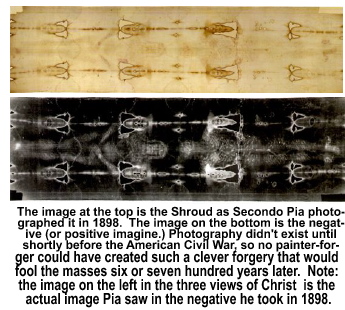 cleverly-created forgery made sometime between 1260 and 1390 AD. Making the announcement together (to prevent differing views once the press conference concluded), were Hall, Tite and Hedges.
cleverly-created forgery made sometime between 1260 and 1390 AD. Making the announcement together (to prevent differing views once the press conference concluded), were Hall, Tite and Hedges.
As far as they were concerned, and the leftwing media (like most leftwing wingnuts today), the debate was over. The half inch by three inch square of fabric they carbon-dated said it all. And, as Hall said at that time, "...there is no other evidence that needs to be examined." Why? Because all—not just some—of that evidence refuted what they saw in that half inch by three inch piece of cloth of unknown origin. Not a single reporter asked the question of how a 13th or 14th century forger could perfectly counterfeit a negative image which, when photographed four or five centuries later would produce the perfect positive photographic image of a crucified man when the photographer, 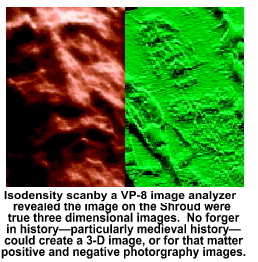 Secondo Pia, started to develop what should have been a negative image of the Shroud on the glass plate. Hall, Tite and Hedges never attempted to explain how a 14th or 15th century fake could flawlessly replicate a photographic negative image that would not exist until the mid-19th century, or for that matter, imagine that somewhere down road to the future someone would invent a devise that would take someone's, or something's picture. But,.what's more, that in the future, man would invent a VP-8 Image Analyzer which would measure, in a process known as isodensity, the distance between the cloth and and the individual parts of the body beneath it, touching the cloth which would produce a three dimensional image. The isodensity scanner showed that two lepton coins minted by Pontius Pilate in 31 or 32 AD held closed the eyes of the crucified man until rigor mortis set in. Not even Michelangelo could have created that forged "painting."
Secondo Pia, started to develop what should have been a negative image of the Shroud on the glass plate. Hall, Tite and Hedges never attempted to explain how a 14th or 15th century fake could flawlessly replicate a photographic negative image that would not exist until the mid-19th century, or for that matter, imagine that somewhere down road to the future someone would invent a devise that would take someone's, or something's picture. But,.what's more, that in the future, man would invent a VP-8 Image Analyzer which would measure, in a process known as isodensity, the distance between the cloth and and the individual parts of the body beneath it, touching the cloth which would produce a three dimensional image. The isodensity scanner showed that two lepton coins minted by Pontius Pilate in 31 or 32 AD held closed the eyes of the crucified man until rigor mortis set in. Not even Michelangelo could have created that forged "painting."
But before we get too deeply into the why and how questions which Hall, Tite and Hedges never asked, particularly after they were advised that to have a reasonably accurate analysis, they needed a swatch at least the size of a man's handkerchief—not a snippet from the corner of the shroud that was 1/2 inch X 3 inches.
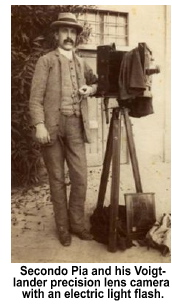 In the Museum of the Shroud in Turin, Italy is a 1898 relic which made a lesser known relic more than just a relic. The first relic, a late 19th century plate camera with a Voigtlander precision lens flipped the accepted perception that the medieval relic, the Shroud of Turn ([also referred to by some as the Holy Mandylion of Edessa [or Constantinople]) very likely contained the image of Jesus Christ.
In the Museum of the Shroud in Turin, Italy is a 1898 relic which made a lesser known relic more than just a relic. The first relic, a late 19th century plate camera with a Voigtlander precision lens flipped the accepted perception that the medieval relic, the Shroud of Turn ([also referred to by some as the Holy Mandylion of Edessa [or Constantinople]) very likely contained the image of Jesus Christ.
The first official photographer of the Shroud of Turin, pictured on the right, was Secondo Pia. with his Voightlander camera. While the world would not pay attention to the work he did on Oct. 18, 1898 for several years, a series of primitive photographs have now outweighed what appears to be a botched carbon-dating based on the evidence provided by the image itself, which serious investigators are now convinced was neither a fabrication nor a forgery. It appears what Hall, Tite and Hedges radio-carbon tested was not the actually twill linen shroud, but woven patches added to repair damage to the Shroud over the centuries.
Historians seem to agree that the burial cloth was in possession of the Muslim world at least until the siege of Edessa in 1144 AD. Which is strange since the Muslims hated Christians as much as Jews, and when they sacked Christian villages, they always burned their churches, killed the Christian peasants and destroyed every Christian relic they found.
Had the Muslims taken possession of the Shroud, which was revered as the burial cloth of Jesus by the Eastern Orthodox Christians in Edessa, they would have destroyed it after Jerusalem was taken in 637 AD by the Rashidun general, Abu Ubidah. When Jerusalem finally surrendered, Caliphate Umar personally traveled from Medina to Jerusalem to accept its surrender. Umar granted the Christians and Jews in Jerusalem some freedom to worship their God under what is historically known as the Umariyya Covenant in exchange for jizya (an annual income tax levied by the Muslims on all conquered non-Muslims [dimminis].)
The freedom to worship God was contingent upon obedience to the laws and ordinances of Islam. While there is absolutely no evidence to substantiate it, I am nevertheless convinced that the Shroud never left Jerusalem from around 32 AD until after the deaths of Peter and James in 65AD. I believe that because while the linen cloth was revered by those of the Christian faith, when the persecution of Christians by Nero began in 64 AD, there is no further record of anyone seeing the Shroud until the 13th century—after the Fourth Crusade when it became the possession of Geoffroy de Charney I, the Templar Knight, sometime between 1202 and 1204 AD.
I believe, without evidence to prove it, that the Shroud remained hidden in the catacombs beneath Jerusalem in an earthen jar, probably until the stoning death of James, the half-brother of Jesus and the head of the Christian church since 33 AD and the crucifixion of Peter that same year, 65 AD. Sometime later the Shroud of Christ appeared in Edessa (a Christian city-state surrounded by Muslim countries) and, for a while, it was called "the cloth of Edessa." In 944 AD, Emperor Romanus of Constantinople sent his army to Edessa specifically to seize the Shroud (still referred to as the Cloth of Edessa or the Edessa Cloth). When Constantinople came under siege by the Turks, the Shroud, now sealed in earthen pottery was hidden until it was found by the Knights Templar.
This walk down history's memory lane was made necessary by the Oct. 13, 1986 examination of the Shroud by Hall, Tite and Hedges, but specifically by Oxford's atheist Edward Hall, an agnostical proponent of evolution. Hall used radio-carbon dating as a means to discredit creationism which he thought was bogus hocus pocus. Hall's view were the dominant view of the radio-carbon dating team not just because he was the team leader or "expert" in radio-carbon dating," but because he was an extremely influential millionaire who possessed the ability to sway the media if his teammates did not publicly agreed with him.
After Hall died, Dr. Tite became the head of Oxford's radio-carbon-dating project. In one interview with the media, Tite said he favored another radio-carbon dating test largely because, he admitted, to get an accurate radio-carbon dating analysis, you need a sample of the Shroud at least the size of a man's handkerchief from the actual Shroud itself and not a half inch by three inch swatch of what was likely an edging that was not part of the ancient twill linen shroud but one of many patches .a
It's not surprising that the social progressive media and the experts in radio-carbon dating championed Hall's misstep, because how would they look if the world discovered these three radio-carbon geniuses couldn't tell the difference between a three-to-one herringbone weave linen fabric and a simple one-over, one-under muslin cloth—and protecting a 13th or 14th century patch was more important than acknowledging that the Shroud of Turin or the other three names it was known by, was and still is, the actual burial cloth of Jesus Christ. And, what's more, the image on the Shroud is a photographic image of Our Lord and Savior, Jesus Christ.
As a post script, let's take one last glance at how Jesus came to be laid to rest on a burial sindon of a rich man, and interred in that rich man's tomb. Shortly before Christ was crucified, Joseph of Arimathea, a rich man and a devout disciple of Jesus (who was also a member of the political council appointed by Pontius Pilate to advise Rome on maintaining a peaceful relationship with the Jews in Palestine), asked Pilate for the body of Jesus to prepare Him. for burial. Joseph took the burial cloth purchased for his own death, an expensive three-hop twill weave yellow linen sindon, which is a permanent burial cloth as opposed to a shroud, which is a cheap, single weave cloth used temporarily to cover the dead before they are prepared with spices and then wrapped for for burial. A three-hop sindon is a three-to-one herringbone linen twill shroud composed of flax fibers. Joseph of Arimathea's sindon was 14.3' X 3.7'. In his final resting place, in the tomb he had also already purchased, Joseph envisioned himself being laid to rest on the lower half of the sindon, with the top half draped over him, head to foot. Remember that construction because the patches used over the centuries to repair burn marks and disintegrated edges of the Shroud were single weave materials—no twills. Which means, they could not have been part of the Christ's burial shroud on April 6, 32 AD.
One last thing. All of the physical evidence examined by forensic scientists say the Shroud is the actual burial cloth of a bearded man in the 1st century AD. The only thing which disputed that forensic evidence was Hall, Tite and Hedges who, as much as they wish to deny it, examined a patch and not a sample from the actual herringbone weave shroud. How do I know that? Because the Catholic Church has venerated and protected the Shroud since Clement VII. There is no way the Church fathers would desecrate, or allow anyone else, to desecrate a holy relic of the Church.
That said, the company which examined much of the microscopic particles of physical evidence—pollen particles, sand, and grit found plain old mud imbedded in the yellow linen cloth where Christ's feet were nailed to the cross. The scientific testing of the dirt was done by Hercules Aerospace Company and the Enrico Fermi Institute for Nuclear Studies. After intense testing, their scientifically-proven conclusion is that some of the dirt particles at foot-level proved to be traveline aragonite limestone. Using a high-resolution microprobe, Richard Levi-Swetti and Joseph Kohlbeck compared the spectra of the samples with the tomb limestone and found the samples to be identical except for minute fragments of cellulose linen fibers that could not be separated from the Shroud samples. The question is: how does first century AD tomb dirt find its way on a 14th century forgery? It doesn't. Second, how does first century tomb dirt end up on a 14th century patch? From folding and unfolding the shroud, and the linen sindon brushing against the muslin patch. Unless you are naive enough to believe that the 14th century forger managed to peer almost a thousand years into the future and created a three dimensional negative photographic image to fool scientists in 1986.

Copyright © 2009 Jon Christian Ryter.
All rights reserved.


